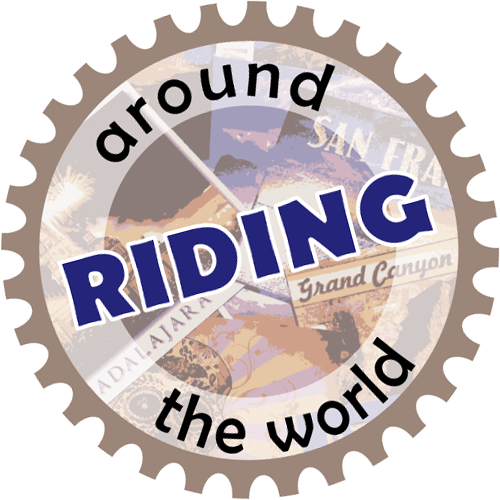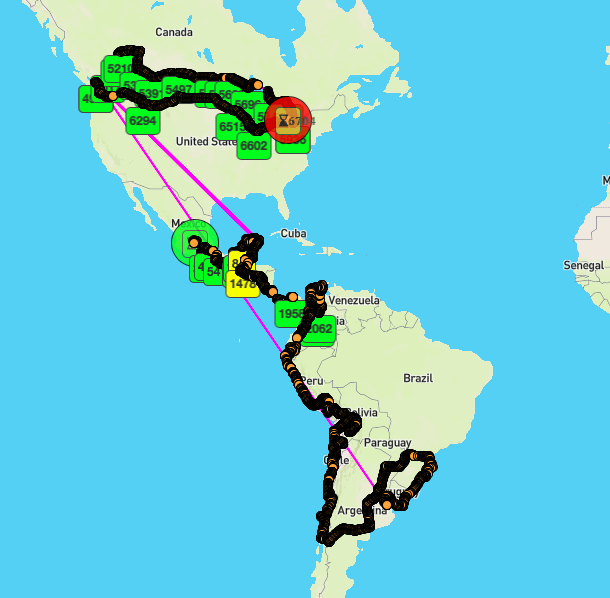The plan for Friday was to visit the Volcán Poás, a 2,708-metre volcano that is an hour and a half away from San José. We embarked on our journey mid-morning and about an hour into it, we passed by a large industrial cylinder with the Starbucks logo plastered across it. Phil, being the attentive rider that he is, hadn’t noticed it until I exclaimed “Starbucks!” We figured it was likely a coffee farm; however, we weren’t sure if there was any public access to it. Nonetheless, I convinced Phil to turn the bike around so I could at least take a picture of him in front of the giant Starbucks logo.
We pulled into the parking lot and discovered that not only was it open to the public, the farm had a visitor center and a large store where they also roasted the beans for all the coffee-based beverages they served. Hacienda Alsacia is the only coffee farm in the world that is owned by Starbucks and had been open since March 7 of this year so, a little over two weeks before we stumbled upon it. How’s that for a lucky coincidence?
The center offered a 90-minute tour for 30 USD per person and, obviously, we jumped at it. We had some time before our tour started so we took the opportunity to get some lunch and look around a bit on our own. I never would have thought that a coffee farm could be as beautiful. The seating area of the store overlooks the rolling hills of lush greenery that makes up the 600-acre farm while the walls of the facility itself are adorned with stunning murals, courtesy of Peruvian street artist Jade Rivera.
- The visitor center
- The store
- Seating area
- Lunch with a view
- Don’t mind if I do
- View of the farm
- Mural by Jade Rivera
- Introspección by Jade Rivera
- El Recolector by Jade Rivera
Our tour started shortly after we finished lunch and was conducted by Mario, a very friendly and knowledgeable gentlemen who spoke excellent English like the rest of the staff at the facility. He gave us a bit of a background on the farm and its field workers. We were initially surprised to discover that 70% of the coffee pickers come from the neighbouring countries of Nicaragua and Panama. Education is free and mandatory for residents under 18 in Costa Rica and the population has a higher literacy rate due to this so, there is a labour shortage for menial jobs. In addition to paying a fair wage, Starbucks provides housing and meals for the families, and sends their children to school (no child is allowed to work in the fields) throughout their time at the farm.
Mario also showed us around the facility and schooled us on everything from planting the first seed and through the whole process it takes to get to that perfectly-brewed cup. Their cognizance of environmental sustainability is impressive. The facility is primarily powered by energy from solar panels and even the machines used in the washing and pulping processes require just a mere fraction of the water normally used. They also repurpose as much as they can to reduce the environmental impact of their operations.
- Starting from the seeds
- The washing process
- The pulping process
- Drying the old-fashioned way
- The drying process
- Sun-dried beans
We were shown the bodega where only the premium-quality, undamaged beans are separated to be sold under the Starbucks umbrella. It turns out that even beans that are merely broken and otherwise undamaged make a big difference when it comes to the taste. We were also taken inside the greenhouse where the agronomist conducts research on disease resistance and other best practices for growing coffee beans, which he shares with the world through open source. In fact, if you want to start a coffee farm, you can go to Starbucks and get a strong and disease-resistant plant to produce your own premium-quality beans, no strings attached. Career change, anyone?
- Inside the bodega
- The research greenhouse
- Growing the best plants
After touring all the various parts of the facility, we returned to the store and were ushered towards the back where the roaster stood. We were given a demonstration of how the coffee beans are roasted and shown the different stages of roast. The beans sent from this farm to Seattle are roasted darker than the beans they bag and sell locally. We did not have the opportunity to try the darker ones, but we did finish off the tour with a tasting of the beans sold locally and ended up buying a bag to take with us.
- The roaster
- Locally-bagged beans
- Coffee tasting
We had planned to still visit the volcano after we finished with our visit at the Starbucks coffee farm; however, we discovered it was closed when we got there. It turns out that access to the volcano has been closed indefinitely since April 2017 due to an explosion so, if you plan to visit it, be sure to check beforehand.

































